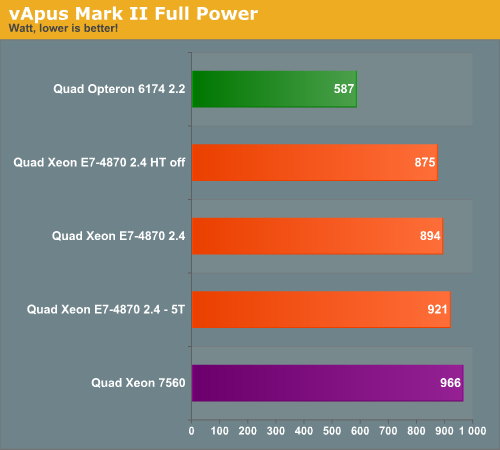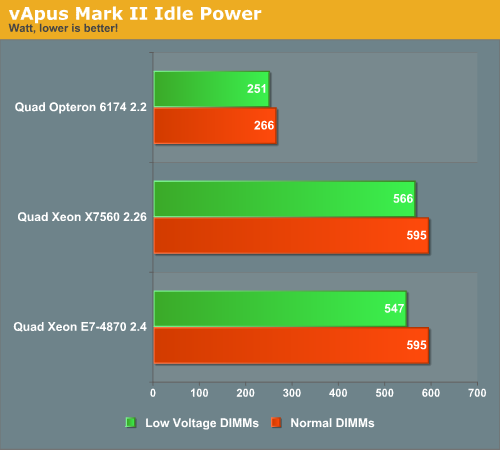Westmere-EX: Intel's Flagship Benchmarked
by Johan De Gelas on May 19, 2011 1:30 PM EST- Posted in
- IT Computing
- Intel
- Xeon
- Cloud Computing
- Westmere-EX
Power Extremes: Idle and Full Load
Idle and full load power measurements are hardly relevant for virtualized environments but they offer some interesting datapoints. In the first test we report the power consumption running vApus Mark II, which means that the servers are working at 85-98% CPU load. We measured with four tiles, but we also tested the Xeon with five tiles (E7-4870 5T).
We test with redundant power supplies working, so the Dell R815 uses 1+1 1100W PSUs and the QSSC-4R uses 2+2 850W PSU. Remember that the QSSC server has cold redundant PSUs, so the redundant PSUs consume almost nothing. There's more to the story than just the PSU and performance, of course: the difference in RAS features, chassis options, PSU, and other aspects of the overall platform can definitely impact power use, and that's unfortunately something that we can't easily eliminate from the equation.

The Quad E7-4870 Xeons save about 7.5% power (894 vs 966) compared to their older brothers. The power consumption numbers look very bad compared to the AMD system in absolute terms. However, with five tiles the Quad Xeon E7 delivers 63% higher performance while consuming 57% more power. We can conclude that at very high loads, the Xeon E7 performance/watt ratio is quite competitive.
When we started testing at idle, we test with both the Samsung 1333MHz 4GB 1.35V (low power) DDR3 registered (M393B5273DH0) and 1.5V DIMMs (M393B5170FH0-H9).

Despite the fact that the Xeon X7560 does not support low power DIMMs officially, it was able to save about 5% of the total power use. The Xeon E7's more advanced memory controller was able to reduce power by 8%. But the picture is clear: if your servers runs idle for large periods of time, the quad Opteron server is able to run on a very low amount of power, while the quad Xeon server needs at least 600W if you do not outfit it with low power 1.35V DIMMs. How much of the power difference comes from the platform in general and how much is specific to the servers being tested is unfortunately impossible to say without testing additional servers.
As we have stated before, maximum power and minimum power are not very realistic, so let us check out our real world scenario.










62 Comments
View All Comments
L. - Thursday, June 2, 2011 - link
Err... no it's not the same price.Besides, "a lot worse on benchmarks" is a huge pile of shit, if that was the case, why would Cray and others take Opteron for SC ?
Why would anyone, in fact, go out of their habits to buy a chip from the underdog ?
Believe me, even if you see a lot favoring Intel, there's a lot favoring AMD that's less shown but there regardless..
As I said, same perf/watt on the anand benchmarks for two chips that are a die shrink away from each other... this is ludicrous.
Casper42 - Thursday, May 19, 2011 - link
I had heard previously that 32GB DIMM Support (Quad Rank) was actually coming from Westmere CPUs themselves as opposed to Mobo or Chipset.The part of the review where you talk a little about the Hardware Intel sent over makes it seem like the Server is the part responsible for the 32GB DIMM support.
Perhaps you could research and clarify a little?
Michael REMY - Friday, May 20, 2011 - link
cinebench benchmark is missing so much...My lord anandtech...?
why didn't you test cinebench on this god machine ?
why not ?
why do you thinh this kind of machine is preferend to server/network instead 3D application ?
even a single cinebench (which is a x64 portable application in windows ) need less 15 minutes to download, unpack, run,re-rerun the test...
why no 3d benchmark in this test. i 'm so desapointed...
:-(
JohanAnandtech - Saturday, May 21, 2011 - link
I'll run that for you, but Cinebench is limited to 64 threads. Other suggestions you would like to see?Veteran_69 - Friday, May 20, 2011 - link
Looking at the power consumption and results. It is clear to me that AMD is better in the Perf/Watt performance. Even with an outdated platform (Why no tests with magny-cours again?)they manage to perform better with the same currentdraw.
JohanAnandtech - Saturday, May 21, 2011 - link
"(Why no tests with magny-cours again?)"What do you mean by this? The AMD Opteron 6174 is one of the best Magny-cours available.
Veteran_69 - Friday, May 20, 2011 - link
Since my previous comment was deleted for whateve reason. I'll rephrase.Why arent there any perf/wat figures? If you look at the data it is Clear that an old AMD platform offers superior Perf/Watt. I also noticed any tests with Magny-cours as a competition is missing?
silverblue - Friday, May 20, 2011 - link
The Opteron 6174 and 6176 are Magny-Cours processors, so they were indeed tested. I believe the choice in using the 6174 for the majority of the review would be down to the 6176's higher TDP as discussed at the following link:http://www.anandtech.com/show/2978/amd-s-12-core-m...
behold4r - Friday, May 20, 2011 - link
I have very much enjoyed reading this article as well as the previous one about the 4p systems of intel which are in fact very interesting i must say, because benchmarks about such systems are very rare to find on the net.I would only like to ask anandtech.com if it is possible to see any rendering benchmarks on such a system. I am using some 3D software and i would very much like to see how the AMD system with the 48 cores is doing when rendering (with mental ray and vray preferably).
I focus on the AMD server system because it really is a very good price per performance example whereas Intel is indeed ahead performance wise, but the prices for an Intel 4P system are astronomical to say the least. I personally believe that very few companies need such a thing, while most of them can do well with an AMD system.
And since you are talking about virtualization, if a company needs more power, just buy another 4P AMD system, the overall result will be a faster system (by far) than a single Intel one, while having the price of a single Intel server! (3K+ for a single intel cpu chip is just outrageous, intel charges like there is noone else on this planet with an equivalent product, at least for the x86 market). Though two AMD systems will use a little more power than a single Intel one (~1150W for 2 AMD servers instead of ~900W for a single Intel based on the info of this article, which is not that much ahead if you think of the performance you gain).
Then again there are the infrastructure costs (more 10 gig ports for the extra system, extra UPS load thus more UPS power to handle the extra system, extra space in the rack, and of course extra cooling for the 2nd system). Which I think these issues are the real deal and hence will make the final decision.
Anyway, that's all i wanted to say. Again i only wanted to ask for some rendering benches, if it such a hustle than at least a mere cinebench 11.5 would be fine.
Thanks
Kiijibari - Saturday, May 21, 2011 - link
Where is AES in the CPU-Z screenshot, is it not supported ?Would be very strange for a server CPU, wouldn't it ?